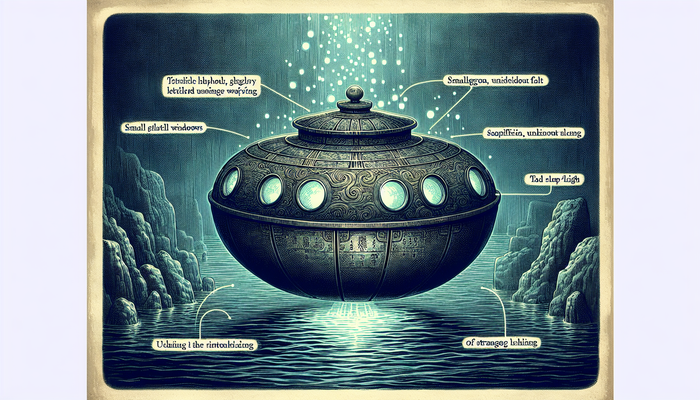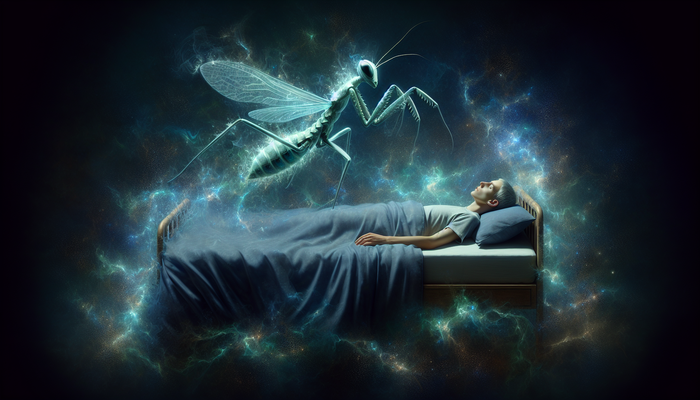Jump Rooms to Mars: The Conspiracy Theory

By Gabriel Chen, Ufologist
Stepping into the Rabbit Hole – Is the Fast Track to Mars Already Here?
Imagine an ordinary-looking elevator tucked away in a nondescript CIA facility in California. You step inside, the doors close, and when they open again seconds later, you're standing on the surface of Mars, 140 million miles from Earth. According to one of the most extraordinary conspiracy theories of our time, this isn't science fiction-it's a classified reality that's been operational since the early 1980s.
This is the world of "Jump Rooms to Mars," a conspiracy theory asserting that the U.S. government possesses technology enabling instantaneous teleportation to the Red Planet. No nine-month journey through the vacuum of space. No radiation shielding concerns. No billion-dollar spacecraft required. Just step into the room, and-jump.
While NASA publicly discusses plans to send humans to Mars in the 2030s and SpaceX's Elon Musk works on massive rockets to colonize the planet, proponents of the Jump Room theory insist we've already been there-secretly and repeatedly-for over four decades.
At the center of these claims stands Andrew D. Basiago, a Washington state lawyer who describes himself as a "chrononaut"-a time traveler and interplanetary explorer for classified government programs. Basiago insists he participated in a secret Mars teleportation program in the 1980s that utilized "jump rooms" to transport young recruits to the Martian surface.
But perhaps the most explosive element of Basiago's claim is his alleged fellow traveler: a teenage Barack Obama, then using the name "Barry Soetero," who would later become President of the United States.
The Genesis of the Jump Room: A Tale of crashed UFOs and Secret Technologies
The origin story of the Jump Room technology reads like a plot from a science fiction thriller. According to proponents of the theory, the teleportation capability wasn't developed through conventional human innovation-it came from the stars.
Specifically, the Jump Room conspiracy centers around the alleged recovery and reverse-engineering of a crashed extraterrestrial spacecraft. This wasn't just any UFO-it supposedly originated from Alpha Centauri, the star system made famous in James Cameron's "Avatar" (though conspiracy theorists were discussing its significance long before the film).
What made this spacecraft unique was its method of travel. The alien vessel reportedly didn't use conventional propulsion but operated through consciousness-directed technology. The pilot, whether human or alien, could simply think of a destination, and the ship would create a wormhole-a tunnel through spacetime-allowing for instantaneous travel to that location.
"The scientist discovered that through the consciousness of a human or alien mind, the ship sets a destination you desire, and opens up a worm hole in front of the ship which transports you to the destination of your liking," explains one source associated with the theory.
The timeline for developing this technology spans decades. According to the conspiracy narrative, the alien craft was recovered sometime after World War II, with German scientists playing a crucial role in the reverse-engineering effort. This adds another layer to the story, linking it to Operation Paperclip-the real post-war program that brought German scientists to America-and to persistent rumors of Nazi advanced technology research.
"Germans were very, very intelligent and they were the most advanced in science and mathematics compared to any other country including United States," notes one source advocating the theory. "It took over 40 years to solve the riddles and mysteries of the spaceship which also contained the technology of Jump Room."
This narrative conveniently places the perfection of Jump Room technology in the late 1970s or early 1980s-just in time for the alleged recruitment of Basiago, Obama, and others into the Mars program. It also creates a technological explanation for how instantaneous travel to Mars could be possible, sidestepping the insurmountable challenges of conventional interplanetary travel.
The alleged source of this technology also connects to another persistent conspiracy theory-that humanity's first encounter with extraterrestrial artifacts occurred on the Moon. "Tycho crater on moon was the first place where humans found the first evidence of alien civilization, with a black 'Monolith'," claims one source, directly referencing Stanley Kubrick's "2001: A Space Odyssey," further blurring the lines between science fiction and conspiracy theory.
The Architects of the Concealment: CIA, DARPA, and the Shadowy Program
Any sufficiently dramatic conspiracy theory requires powerful institutions to maintain secrecy, and the Jump Rooms to Mars narrative centers two particularly potent organizations: the CIA and DARPA (Defense Advanced Research Projects Agency). According to Basiago and fellow claimant William Stillings, these agencies managed a covert program facilitating teleportation between Earth and Mars, operating entirely outside public knowledge or congressional oversight.
What makes this claim particularly intriguing is the alleged involvement of Regina Dugan, who would later become the actual head of DARPA from 2009 to 2012. Basiago and Stillings assert that Dugan, like Obama, was part of their "Mars training class" at California's College of the Siskiyous in 1980. If true, this would represent an extraordinary case of a program participant eventually leading the very agency overseeing the secret technology.
The conspiracy narrative attributes ambitious, even audacious goals to this classified Mars program. First was the establishment of a "defense regime protecting the Earth from threats from space"-essentially using Mars as a forward operating base against potential extraterrestrial threats. Second was securing "territorial sovereignty" for the United States on Mars, essentially claiming the planet through covert visitation before any public international missions could arrive.
This territorial ambition is particularly notable when viewed against the backdrop of real space law. The 1967 Outer Space Treaty, which the United States signed and ratified, explicitly forbids national appropriation of celestial bodies "by claim of sovereignty, by means of use or occupation, or by any other means." The alleged Jump Room program's territorial goals would represent a direct contravention of this foundational space law treaty.
Perhaps the most extraordinary element of the claimed program involves its interactions with indigenous Martian life. According to the conspiracy theory, the teleportation missions were intended to help "acclimate Martian humanoids and animals to their presence" in order to secure a U.S.-Martian alliance. This stands in stark contrast to mainstream scientific exploration, which still debates whether microscopic life might have existed on ancient Mars.
The presence of intelligent, humanoid Martians in this narrative introduces unique dangers for the young teleportation explorers. Former Army Major Ed Dames, allegedly involved in training the recruits, reportedly instructed them: "Simply put, your task is to be seen and not eaten." This darkly humorous phrase encapsulates the supposed peril of these missions-presenting Mars not as a lifeless desert but as a populated world with potentially hostile inhabitants.
The "Jump Room" Phenomenon: More Than Just an Elevator
What exactly is a "Jump Room" in the context of this conspiracy theory? Far more than mere metaphor, it's described as a physical installation-most commonly in the form of an ordinary-looking elevator-that houses extraordinarily advanced technology. According to the narrative, the primary Earth-based Jump Room was located in a CIA laboratory in El Segundo, California.
The banality of the Jump Room's appearance serves a dual purpose within the conspiracy framework. First, it provides operational security through its unassuming nature-no one would suspect an ordinary elevator of being an interplanetary transportation device. Second, the contrast between mundane appearance and miraculous function reinforces a recurring theme in many conspiracy theories: that world-changing technology exists just beyond our awareness, hidden in plain sight.
A critical technical detail in the Jump Room theory involves the need for a receiving station at the destination. According to the conspiracy narrative, you can't simply "jump" to any location in the universe-there must be compatible technology at both ends of the journey. This creates a chicken-and-egg problem: how did the first Jump Room get established on Mars?
The answer, according to proponents, lies in a radical reinterpretation of NASA's robotic Mars missions. They claim that probes like Beagle 1, 2, and 3 weren't merely sent to gather scientific data and images as publicly stated. Instead, "NASA has seen enough of Mars, much before they announced it with their phony mission of Beagle. The main function for sending Beagle to Mars was to set up the elevator of jump room, which will act as the receiving end catcher for any object or human to be transported there."
The first successful deployment of this receiving technology allegedly occurred in 1996, timed with the landing of the Pathfinder mission and its Sojourner rover. While NASA celebrated what they publicly described as "a camera on wheels taking pictures and samples on Mars," conspiracy theorists claim this mission was actually establishing the infrastructure for human teleportation.
This reframing of public space missions as cover operations serves an essential function within the conspiracy narrative. It acknowledges the visible, documented achievements of space agencies while simultaneously suggesting these accomplishments mask far more advanced capabilities. It allows believers to accept the reality of NASA's Mars rovers while maintaining that the agency is hiding its true technological capabilities.
The "Chrononauts": Participants, Training, and Extraordinary Encounters
The core of the Jump Room conspiracy centers around its alleged participants-young people recruited into a program so secret that, decades later, only a handful have come forward with their stories. According to Andrew Basiago and William Stillings, approximately ten youths were selected for the Mars training program in 1980, forming what the Wired article colorfully described as an interplanetary "Teen Titans."
Most prominently, they claim that a 19-year-old Barack Obama, then known as "Barry Soetero," was among their fellow recruits. This extraordinary assertion places the future President of the United States at the center of what would be, if true, the most classified and technologically advanced program in human history. The political implications are staggering-suggesting that a U.S. president had direct knowledge of both advanced teleportation technology and the existence of Martian life, yet maintained these secrets throughout his presidency.
The list of alleged participants extends beyond Obama and includes several individuals with connections to America's political and space exploration elite. Mary Jean Eisenhower, granddaughter of President Dwight D. Eisenhower, is named as a participant. So too is Admiral Stansfield Turner, who served as CIA Director from 1977 to 1981-a period overlapping with the alleged Mars program. Perhaps most surprisingly, Buzz Aldrin-the second human to walk on the Moon during the Apollo 11 mission-is also claimed to have been involved.
The training for these teleportation missions allegedly took place at Camp Siskiyous in Weed, California. This remote location in northern California, near Mount Shasta (an area long associated with various New Age and mystical beliefs), supposedly provided the secrecy required for such extraordinary preparation. Major Ed Dames, known to many in the paranormal community for his later work in remote viewing, is claimed to have been one of their instructors.
According to Basiago, his actual visits to Mars occurred between 1981 and 1983. During one such trip, he claims to have encountered Obama on the Martian surface. "Basiago, a fellow chrononaut, told the website Exopolitics that he saw Obama 'walk back to the jump room from across the Martian terrain,'" reports the Wired article. When they met, Obama reportedly acknowledged his fellow traveler with a fatalistic "We're here"-a phrase that, in Basiago's telling, carried significant emotional weight.
The narrative of these alleged Mars visits includes details about the environment and conditions they encountered. Basiago and Stillings describe a challenging landscape with indigenous life forms, both humanoid and animal, presenting potential dangers to the human visitors. The instruction to "be seen and not eaten" takes on practical significance in this context, suggesting missions that were as much diplomatic as exploratory-establishing human presence while avoiding becoming prey to native Martian species.
The Official Scrutiny and Alternative Narratives
When confronted with the claim that a sitting U.S. President had previously teleported to Mars as a teenager, the White House response was understandably dismissive. In 2012, when Wired magazine contacted the Obama administration about Basiago and Stillings' assertions, Tommy Vietor, then spokesman for the National Security Council, offered a succinct and somewhat humorous denial: Obama had only been to Mars "if you count watching Marvin the Martian."
This lighthearted dismissal is typical of how officials respond to conspiracy theories they view as too outlandish to merit serious engagement. By referencing a cartoon character, Vietor effectively communicated the administration's position that the claims belonged in the realm of fiction, not fact.
However, even within communities that discuss the Jump Room claims, there isn't a single, unified interpretation of what might have occurred. Three main possibilities emerge from the discourse around Basiago's assertions:
The first possibility is that the claims are literally true-that the CIA and DARPA genuinely developed teleportation technology from crashed alien spacecraft and used it to send young people, including the future president, to Mars. This straightforward interpretation takes Basiago and Stillings' accounts at face value and accepts the existence of both the technology and indigenous Martian life.
A second interpretation suggests that while Basiago and the others may have genuinely believed they went to Mars, they were actually subjects in an elaborate psychological experiment or simulation. Under this theory, the CIA created immersive environments or used advanced mind-altering techniques to convince participants they were teleporting to Mars when they were actually experiencing a sophisticated illusion. This would align with documented CIA projects involving psychological experimentation, such as MKUltra, but on a far more advanced scale.
The third possibility posits that the Jump Room narrative itself is a cover story-a "limited hangout" in intelligence jargon-designed to obscure an actual secret space program using more conventional (but still classified) technology. In this view, discussions about teleportation and jump rooms serve to discredit legitimate investigations into covert space activities by associating them with clearly fantastic elements.
These competing interpretations highlight an interesting feature of many complex conspiracy theories: they contain internal debates and alternative explanations, demonstrating that conspiracy thinking isn't monolithic. Proponents may agree that official narratives are false without necessarily agreeing on what the truth actually is.
Weaving the Threads: Connections to Broader Conspiracy Ecosystems
The Jump Room to Mars conspiracy doesn't exist in isolation-it's interconnected with a web of other conspiracy theories about secret space programs, hidden technologies, and suppressed knowledge. This network of interlocking beliefs creates a comprehensive alternative worldview where the Jump Room narrative feels like just one revealed piece of a much larger hidden reality.
One significant connection is to the broader concept of "secret space programs"-the belief that governments or private organizations have achieved space capabilities far beyond what's publicly acknowledged. This includes claims of a German Mars colony allegedly established in the 1940s by secret societies using "hidden bases in South America and Antarctica to explore technologies like space time portals." The Jump Room fits neatly into this tradition, suggesting that conventional space programs serve mainly as cover for more advanced, classified activities.
Basiago's claims extend beyond Mars teleportation to encompass time travel as well. He asserts that before his participation in the Mars program, he was involved in "Project Pegasus" during the 1970s-an alleged DARPA initiative that developed time travel technology. This connection to time travel expands the scope of the conspiracy, suggesting that the government possesses mastery over both space and time. The soundcloud.com source indicates Basiago describes himself as having served "as a US Chrononaut in Project Pegasus during the advent of time travel and in Project Mars during the advent of interdimensional travel."
The concept of "jump gates" or "stargates"-technologies permitting instantaneous travel across vast distances-appears in multiple conspiracy theories and has been the subject of supposed remote viewing sessions mentioned in the spreaker.com source. These frameworks position the Jump Room as just one manifestation of a broader technology that might exist at multiple locations around the Earth or even in space.
A striking contrast exists between the Jump Room claims of encountering "Martian humanoids and animals" and the scientific search for microbial life on Mars. While NASA scientists carefully examine Martian soil for chemical signatures that might indicate past microscopic life, the Jump Room narrative presents a Mars teeming with complex organisms-a dramatic divergence that highlights how conspiracy theories often offer more emotionally satisfying narratives than the methodical incremental progress of science.
The territorial aspect of the Jump Room conspiracy-establishing U.S. "sovereignty" on Mars-connects to very real debates about space law and property rights. As the voelkerrechtsblog.org source discusses, SpaceX's Starlink terms of service once contained language declaring Mars "a free planet" not subject to Earth-based authority, which conflicts with the Outer Space Treaty's principle of non-appropriation. The Jump Room narrative, with its goal of claiming Mars for the United States, mirrors these actual tensions about how space resources and territories should be governed.
Government secrecy and deception form the foundation upon which the entire Jump Room narrative rests. The theory positions NASA's public Mars exploration efforts as elaborate theater to conceal the real, advanced capabilities already in use. This aligns with other space conspiracy theories, such as those claiming NASA regularly hides evidence of UFOs or that the Moon landings were filmed on a sound stage. The common thread is a deep distrust of official explanations and a belief that truly significant discoveries and capabilities are kept hidden from the public.
Beyond the Speculation: The Reality of Reaching Mars
While the Jump Room conspiracy offers an almost magical vision of instantaneous travel to Mars, the actual challenges of sending humans to the Red Planet are substantially more complex and daunting. These real obstacles help explain why, despite decades of planning, humans have yet to set foot on Martian soil.
The journey to Mars using conventional rocket technology takes approximately seven months each way-a period during which astronauts would be exposed to serious hazards. Chief among these is radiation. As the wikipedia.org source notes, "In May 2013, NASA scientists reported that a possible mission to Mars may involve great radiation risk based on energetic particle radiation measured by the radiation assessment detector (RAD) on the Mars Science Laboratory while traveling from the Earth to Mars in 2011–2012." Without the protection of Earth's magnetic field, travelers would face radiation doses that increase cancer risk and potentially cause radiation sickness.
Another significant challenge is the effect of microgravity on the human body. Extended periods in zero or reduced gravity cause bone mineral density loss, muscle atrophy, cardiovascular changes, and eyesight impairment. A 2020 study cited in the wikipedia.org source predicted "33% of astronauts will be at risk for osteoporosis during a human mission to Mars." While exercises and countermeasures can reduce these effects, they cannot eliminate them entirely.
The psychological impact of long-duration spaceflight presents yet another hurdle. The MARS-500 experiment, conducted between 2007 and 2011, isolated crews in a mock spacecraft to study the effects of a simulated Mars mission. The wikipedia.org source reports that "four of the six crew members had considerable problems sleeping, and increased sleep and rest times, in behaviour compared to animal hibernation." This highlights the mental toll of prolonged isolation and confinement-factors entirely bypassed in the instantaneous Jump Room scenario.
Landing safely on Mars represents perhaps the most technically challenging aspect of a mission. The Martian atmosphere is too thin to provide substantial slowing through aerobraking alone (as on Earth) but thick enough to cause serious complications during descent. This "in-between" quality has led engineers to describe Mars landings as "seven minutes of terror," where complex systems must work perfectly without real-time intervention from Earth due to communication delays.
Actual Mars exploration has proceeded through a methodical series of increasingly complex robotic missions. Beginning with Mariner 4's flyby in 1965, progressing through the Viking landers in the 1970s, and continuing with sophisticated rovers like Curiosity and Perseverance, each mission has built upon the knowledge gained from its predecessors. This steady progression stands in marked contrast to the Jump Room narrative's claim of fully-formed teleportation technology in the early 1980s.
Research into in-situ resource utilization (ISRU)-using Martian materials to produce necessities like fuel, water, and building materials-represents a practical approach to reducing the enormous cost of shipping everything from Earth. The nap.nationalacademies.org source describes how "methane and oxygen can be produced using Martian H2O (preferably as water ice instead of liquid water) and atmospheric CO2 with sufficiently mature technology." This approach acknowledges the reality of resource constraints rather than sidestepping them through fantastical technology.
The "Jump Room" in the Cultural Imagination: Art, Media, and Enduring Appeal
Despite its factual implausibility, the Jump Room to Mars narrative has captured imaginations and permeated aspects of culture beyond conspiracy theory circles. This cultural resonance reveals something meaningful about human desires, fears, and fascination with space exploration.
Perhaps the most direct cultural engagement with the Jump Room concept comes through art. As mentioned in the theoldwaterworks.com source, artist Richard Whitby created an exhibition titled "The Jump Room" in 2017, which incorporated "a newly commissioned two-screen video installation with a set of drawings, a performance in Southend-on-Sea... with Sooyon Kim and Siôn Parkinson, and a publication with texts by Honor Gavin and Virginia Woolf." This artwork explicitly derived its name and concept from the conspiracy theory while using it to explore broader themes about narrative credibility and belief systems.
As Whitby explained his interest: "Whilst on the one hand many might accept that the world and its systems are deeply complex and incomprehensible, we still give attention (and therefore value) to relatively simple and therefore palatable versions of these systems. This is something that conspiracy theory arguably shares with, for example, contemporary ethical consumption and connoisseurship."
By examining the Jump Room conspiracy through an artistic lens, Whitby highlights how these narratives function-not just as claims about reality, but as frameworks that simplify complex systems into comprehensible stories. The conspiracy becomes a lens through which to examine how humans create meaning in an increasingly opaque world.
The enduring appeal of the Jump Room conspiracy, despite its extraordinary claims and lack of verifiable evidence, stems from several psychological and cultural factors. First is the fundamental human desire for hidden knowledge-to be among those who know "what's really going on" behind the official narrative. This desire becomes particularly powerful regarding space, which represents both the ultimate frontier and a domain largely inaccessible to ordinary people.
Celebrity involvement significantly amplifies the conspiracy's reach and staying power. The inclusion of Barack Obama in the narrative ensures attention that a similar claim about unknown individuals would never receive. This "Obama factor" has been key to the story's persistence in conspiracy circles and occasional mainstream media mentions, demonstrating how the inclusion of prominent figures can propel even the most extraordinary claims into wider discourse.
The Jump Room narrative also offers a tantalizing technological shortcut to space exploration. While NASA and private companies struggle with the enormous challenges of conventional Mars missions-projected to cost hundreds of billions of dollars and require years of travel-the Jump Room promises instant access to the Red Planet. This appeal to technological wish-fulfillment resonates in a culture increasingly accustomed to immediate gratification and rapid technological advancement.
Perhaps most fundamentally, the Jump Room conspiracy addresses the profound human desire to know whether we are alone in the universe. By asserting not just the existence but the active engagement with intelligent Martian life, it offers definitive answers to questions that mainstream science approaches with painstaking caution. While scientists meticulously analyze soil samples for traces of ancient microbial life, the Jump Room narrative leapfrogs directly to encounters with sentient beings-a far more emotionally satisfying proposition.
The contrast between the Jump Room's utopian vision of instant interplanetary travel and the arduous reality of space exploration reveals different aspects of humanity's relationship with the cosmos. The conspiracy represents our desire for space to be accessible, populated, and already within our technological grasp. The reality of Mars exploration-with its incremental progress, international cooperation, and scientific caution-represents our actual capabilities and methodical approach to the unknown.
This tension between desire and reality, between what we wish space exploration could be and what it actually is, helps explain why narratives like the Jump Room persist despite their factual shortcomings. They fulfill emotional and psychological needs that the slow, methodical progress of actual space science cannot satisfy in the same immediate way.
From Bigfoot to UFOs: Hangar 1 Publishing Has You Covered!
Explore Untold Stories: Venture into the world of UFOs, cryptids, Bigfoot, and beyond. Every story is a journey into the extraordinary.
Immersive Book Technology: Experience real videos, sights, and sounds within our books. Its not just reading; its an adventure.


























